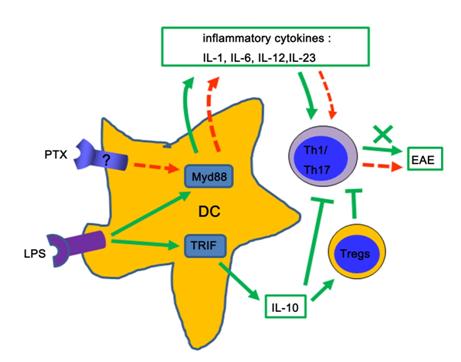
Scientists Reveal Mechanisms for Superiority of PTX to LPS as Adjuvant for EAE Induction
May 26, 2014 Email"> PrintText Size

Multiple sclerosis (MS) is a chronic autoimmune disease of the central nervous system (CNS), characterized by inflammation, demyelination, and axonal pathology. MS is thought to occur in genetically predisposed individuals following exposure to an environmental trigger that activates myelin-specific pathogenic T cells. Experimental autoimmune encephalomyelitis (EAE) is a mouse model for studying MS. PTX has been widely used as an adjuvant to induce EAE. Given the similarities between the DCs maturation and adjuvant properties of LPS and PTX, the difference for them to induce EAE in vivo is unknown.
PhD students ZHOU Haiyan and WANG Yanming, supervised by Dr. SUN Bing at Institute of Biochemistry and Cell Biology, Shanghai Institutes for Biological Sciences demonstrate that LPS does not induce EAE development as PTX does. They show that DCs treated with PTX (PTX-DCs) are able to induce EAE, whereas DCs treated with LPS (LPS-DCs) fail to induce EAE.
The major difference between LPS-DCs and PTX-DCs is that LPS-DCs produce larger amounts of IL-10. IL-10-/--DCs treated with LPS (LPS-IL-10-/--DCs) promote stronger IFN-γ and IL-17 production and T-cell proliferation than wild-type DCs treated with LPS (LPS-WT-DCs) in a co-culture system. EAE is successfully induced when LPS-IL-10-/--DCs are used as an adjuvant, whereas the use of PTX-DCs overexpressing IL-10 (PTX-IL-10-DCs) as an adjuvant markedly reduce EAE development.
These findings suggest that, as compared to PTX, the inability of LPS to induce EAE is most likely due to its ability to stimulate DCs to produce high levels of IL-10 (Figure 1), and in turn IL-10 can suppress Th1/Th17 cell development in EAE induction.
This work, entitled “Differential IL-10 production by DCs determines the distinct adjuvant effects of LPS and PTX in EAE induction”, was published online in European Journal of Immunology on March 7, 2014. It was supported by grants from the National Key Project (973), the National Natural Science Foundation of China, the National Science and Technology Major Project and the CAS/SAFEA International Partnership Program for Creative Research Teams.

Model shows the mechanisms for the superiority of PTX to LPS as an adjuvant for EAE induction. (Image by Dr. SUN Bing ’s group)
Multiple sclerosis (MS) is a chronic autoimmune disease of the central nervous system (CNS), characterized by inflammation, demyelination, and axonal pathology. MS is thought to occur in genetically predisposed individuals following exposure to an environmental trigger that activates myelin-specific pathogenic T cells. Experimental autoimmune encephalomyelitis (EAE) is a mouse model for studying MS. PTX has been widely used as an adjuvant to induce EAE. Given the similarities between the DCs maturation and adjuvant properties of LPS and PTX, the difference for them to induce EAE in vivo is unknown.
PhD students ZHOU Haiyan and WANG Yanming, supervised by Dr. SUN Bing at Institute of Biochemistry and Cell Biology, Shanghai Institutes for Biological Sciences demonstrate that LPS does not induce EAE development as PTX does. They show that DCs treated with PTX (PTX-DCs) are able to induce EAE, whereas DCs treated with LPS (LPS-DCs) fail to induce EAE.
The major difference between LPS-DCs and PTX-DCs is that LPS-DCs produce larger amounts of IL-10. IL-10-/--DCs treated with LPS (LPS-IL-10-/--DCs) promote stronger IFN-γ and IL-17 production and T-cell proliferation than wild-type DCs treated with LPS (LPS-WT-DCs) in a co-culture system. EAE is successfully induced when LPS-IL-10-/--DCs are used as an adjuvant, whereas the use of PTX-DCs overexpressing IL-10 (PTX-IL-10-DCs) as an adjuvant markedly reduce EAE development.
These findings suggest that, as compared to PTX, the inability of LPS to induce EAE is most likely due to its ability to stimulate DCs to produce high levels of IL-10 (Figure 1), and in turn IL-10 can suppress Th1/Th17 cell development in EAE induction.
This work, entitled “Differential IL-10 production by DCs determines the distinct adjuvant effects of LPS and PTX in EAE induction”, was published online in European Journal of Immunology on March 7, 2014. It was supported by grants from the National Key Project (973), the National Natural Science Foundation of China, the National Science and Technology Major Project and the CAS/SAFEA International Partnership Program for Creative Research Teams.

Model shows the mechanisms for the superiority of PTX to LPS as an adjuvant for EAE induction. (Image by Dr. SUN Bing ’s group)
CAS Institutes
There are 124 Institutions directly under the CAS by the end of 2012, with 104 research institutes, five universities & supporting organizations, 12 management organizations that consist of the headquarters and branches, and three other units. Moreover, there are 25 legal entities affiliated and 22 CAS invested holding enterprisesThere are 124 I...>> more
Contact Us

Chinese Academy of Sciences
Add: 52 Sanlihe Rd., Xicheng District, Beijing, China
Postcode: 100864
Tel: 86-10-68597592 (day) 86-10-68597289 (night)
Fax: 86-10-68511095 (day) 86-10-68512458 (night)
E-mail: cas_en@cas.cn

